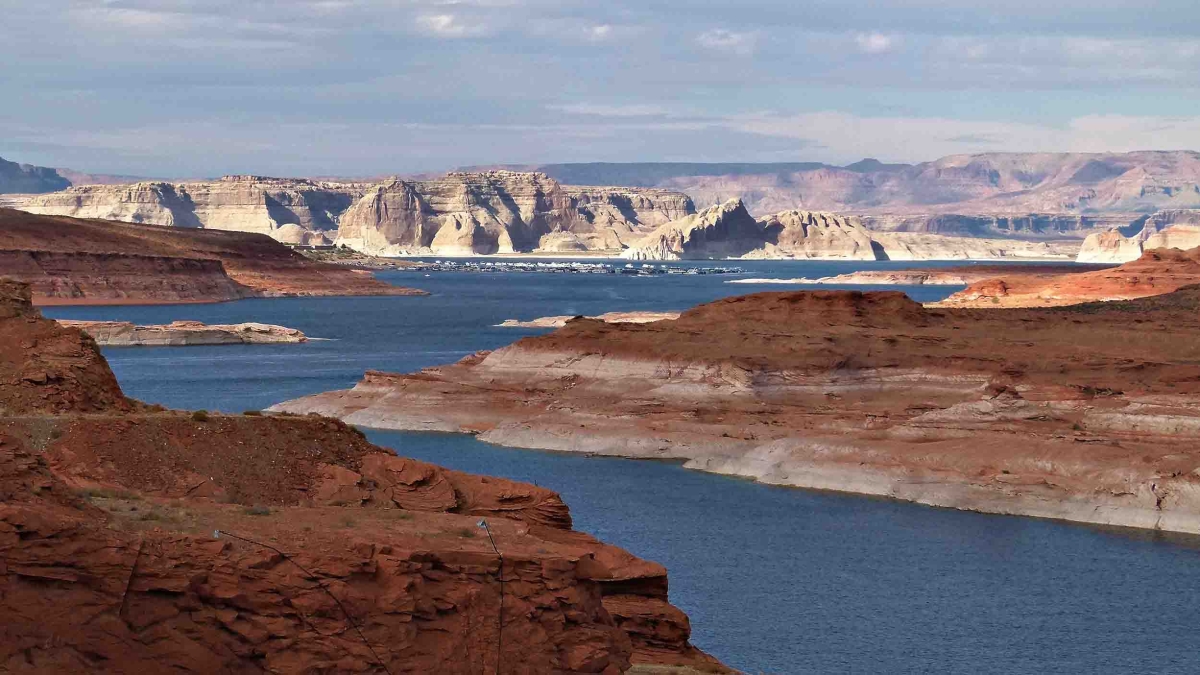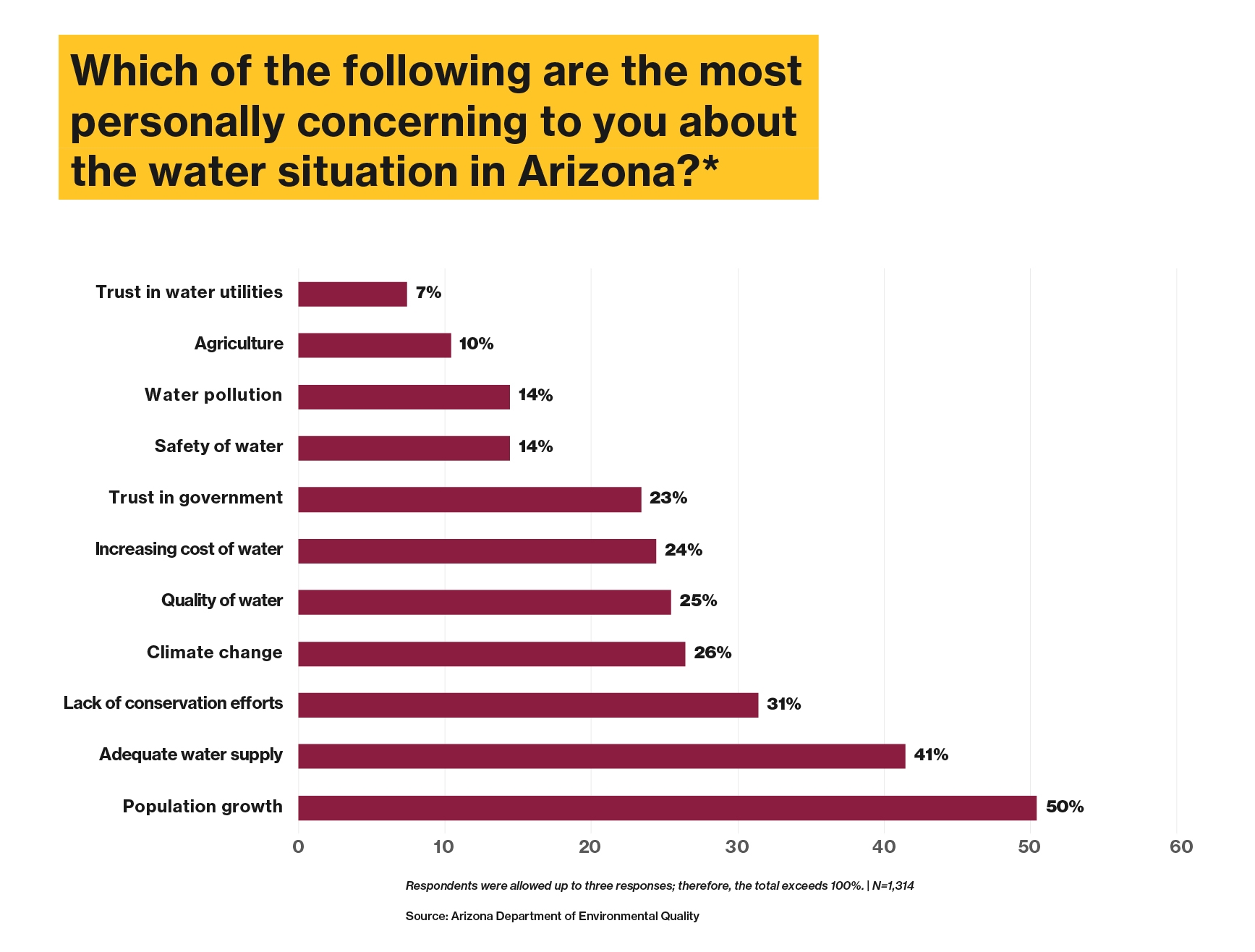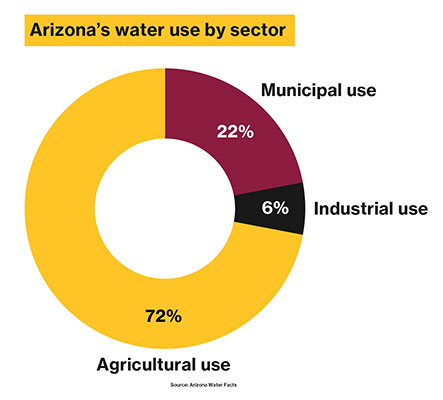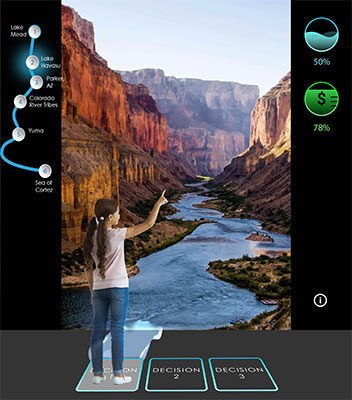With no end in sight for Arizona’s megadrought, many researchers at Arizona State University are developing innovations to mitigate the drought’s effects on residents, agriculture and industry, and promote water resilience and security.
Claire Lauer, a professor of technical communication in the School of Applied Professional Studies, part of the College of Integrative Sciences and Arts (CISA) at ASU’s Polytechnic campus, is applying her knowledge of user experience, or UX, and Arizona’s water landscape to educate the public about the intricacies of water usage because “there’s a lot of misinformation about water out there,” she said. “Educating the public on water management will help communities make informed decisions, which can have a huge effect on Arizona’s water policies and conservation efforts.”
Lauer is collaborating with ASU faculty across disciplines including Scotty Craig, an associate professor in ASU’s Ira A. Fulton Schools of Engineering; Michelle Hale, a teaching professor and scholar in ASU’s American Indian Studies program; and Mina Johnson-Glenberg, an associate research professor in ASU’s Department of Psychology, to develop an engaging mixed-reality game and accompanying museum installation designed to convey the complexities of water allocation across Arizona.
The team is also coordinating efforts with the Smithsonian Museum on Main Street in Washington, D.C., the Arizona Science Center in Phoenix, and eight tribal and rural museum sites across Arizona to make the mixed-reality game informative, relevant and entertaining. The innovation, known as WaterSIMmersive, has just been awarded a $2 million, four-year grant from the National Science Foundation to further develop the project.
The project grew out of the WaterSIM America computer simulation platform led by Dave White, associate vice president of ASU Knowledge Enterprise and director of ASU’s Global Institute of Sustainability and Innovation. Lauer, who is also a senior global futures scientist in ASU’s Julie Ann Wrigley Global Futures Laboratory, became interested in improving the simulation’s visual design, content and gameflow, and incorporating the general public’s lived experiences with water for a more memorable interaction.
“Professionals in UX can use their skills to make a positive impact in any industry,” Lauer says. “It’s a valuable skill set to have.”
“The truth is that only 22% of water is used by cities and households; 6% is used by industry and 72% is used by agriculture. Yet surveys, like a recent one funded by the Arizona Department of Environmental Quality, show that when it comes to water, people are mostly worried about population growth, with only 10% saying they were concerned about agriculture,” said Claire Lauer, a professor of technical communication in the School of Applied Professional Studies, part of the College of Integrative Sciences and Arts at ASU’s Polytechnic campus. Data courtesy of Arizona Water Facts and the Arizona Department of Environmental Quality; graph by Marcos Rodriguez/ASU
The truth about water
Researching public perceptions about water and gathering a team of subject-matter experts in education, psychology, technology and tribal water policy were Lauer’s initial priorities.
“Ninety percent of the water used indoors in the Phoenix area is treated and recycled, yet many Phoenix residents we’ve spoken to think that taking shorter showers and conserving water indoors will help. The majority of a home’s water is, in fact, lost through outdoor landscaping,” said Lauer, who also serves as the chief UX architect for the Arizona Water Innovation Initiative — a $45 million initiative that includes $40 million from the state of Arizona and $5 million from the Virginia G. Piper Charitable Trust. The initiative — created to strengthen Arizona water resilience — is led by ASU’s Julie Ann Wrigley Global Futures Laboratory and the Fulton Schools.
In Arizona, 22% of water is used by cities and households; 6% is used by industry; and 72% is used for agriculture.
Data courtesy of Arizona Water Facts and the Arizona Department of Environmental Quality; graph by Marcos Rodriguez/ASU
Lauer said that the amount of water used for farming is cause for concern because “large parts of rural Arizona are dependent on non-renewing groundwater and have no laws about the amount of water that can be pumped, so they are vulnerable when new agricultural operations move in and water demand rises unsustainably. By contrast, Arizona’s most populous areas are located in Active Management Areas, which have laws managing groundwater use.”
She believes that misconceptions like these occur because scientific research is often discussed in ways that are too abstract to resonate with the general public.
In her published research and UX courses, Lauer encourages the use of a “transactional design model” when developing public-facing science communications, so that communications make clear how the knowledge will matter to the lived experiences and values of the public.
To ensure the mixed-reality game’s message on water management is understood by its intended audience, Lauer connected with Craig, who is also the director of research and evaluation for the ASU Learning EngineeringLearning engineering combines learning sciences, design sciences and the engineering mindset to create solutions for educational ecosystems. Institute and a leading researcher in multimedia learning.
“It’s important to apply multimedia learning strategies throughout the exhibit because this pedagogy is shown to be effective,” said Craig, who joined the WaterSIMmersive project as a co-principal investigator. “Claire will be capturing water data and conversations taking place with residents and stakeholders across the state, and I will organize the discourse for how this information is communicated so it’s effective.”
Bringing visibility to water access
Beyond offering critical information about Arizona’s water landscape, the exhibit intends to share the megadrought’s impact on water in tribal communities, including tribal “adjudication," or the negotiation of legal rights to water.
To ensure that the project’s collaborations with tribal communities are inclusive, credible and sensitive to their needs, Lauer connected with Hale, who works to build bridges between disciplines to enable shared conversations about issues like these.
Hale, who is also a co-principal investigator on the WaterSIMmersive project, is recruiting Indigenous undergraduate and graduate students to start a dialogue with tribal and rural community members all over the state, to gain a better understanding of their water concerns.
“It’s about making sure Indigenous communities are at the table when discussing water,” she said. “This work gives tribal cultural centers and libraries a chance to work with people on the grassroots level to facilitate input on important state-level water issues.”
The WaterSIMmersive experience
After the team spends the first year engaging in community research and developing exhibit features, Johnson-Glenberg will spearhead the design of the game.
She began studying and creating mixed reality and virtual reality as a cognitive psychologist nearly two decades ago.
“Understanding how people learn got me into STEM game-making and using the best pedagogies for education as applied to the digital world,” said Johnson-Glenberg, who is also a co-principal investigator on the project. “To be able to use my experience to co-design this museum installation from scratch with communities around the state is super exciting.”
WaterSIMmersive conceptual illustration courtesy of ASU College of Integrative Sciences and Arts
She said that the 15-foot-tall mixed-reality game (concept pictured at left) will use whole body movements to help visitors understand and embody “systems-level thinking” — a 21st-century skill.
“If a player adjusts how much water they use or save in one area of the game, how will it affect water levels and quality of life downstream? This is an example of systems-level thinking,” Johnson-Glenberg said.
This concept will serve as one of the premises for WaterSIMmersive — educating users on the ramifications of water allocation.
Initial gameplay concepts would give players the opportunity to virtually learn about water circumstances in five different communities along the Colorado River, interacting with characters who are farmers, engineers, Indigenous leaders and other stakeholders who live and work there. Each character will offer their perspectives about how they use water and why water is important to them.
“These avatars will be standing in for people who can’t physically be there to tell their story,” Craig said.
The WaterSIMmersive experience will also include a chatbot enabling participants to ask water-related questions as well as activities that discuss reuse efforts like advanced water purification, ocean desalinationThe removal of salt and other impurities from ocean water to make it drinkable through a process of reverse osmosis, conditioning and disinfection. and other technological advancements that communities are considering.
“We are trying to thread the needle between something that’s engaging, but also educational and memorable,” Lauer said.
WaterSIMmersive will launch in 2025 at an Arizona museum near you
In 2025, WaterSIMmersive will soft-launch at ASU Open Door before the formal pilot opens at the Arizona Science Center. From there, the interactive game will travel to museums and libraries where tribal and rural communities around the state can engage with the game.
“If I can change the perception of young users’ minds of how to allocate water in a way that saves the maximum resources for the maximum number of people, that’s a win for me,” Johnson-Glenberg said about the game, which is targeted for middle-school-aged youth but should be enjoyable for anyone ages 7 to 107.
In 2026, WaterSIMmersive will exhibit at the Bullion Plaza Cultural Center and Museum in Miami-Globe, Arizona; the Fort Apache Heritage Museum on the White Mountain Apache Reservation; the Tubac Presidio State Historic Park and Museum, in Tubac, Arizona; and the Tohono O’Odham Nation Cultural Center and Museum in Sells, Arizona, on the Tohono O'odham Nation. In 2027, it will exhibit at the Page Public Library in Page, Arizona; the Lake Havasu Museum of History in Lake Havasu City, Arizona; and the Colorado River Indian Tribes Museum in Parker, Arizona. Other sites are also under consideration if additional funding is secured.
The team will continue to tweak designs and data visualization based on feedback from game participants.
“This project is directly targeting one of the major problems our generation faces, and that’s understanding water and water conservation,” Craig said. “We have to start educating now. It’s too important not to.”
Sean Williams, the director of ASU’s School of Applied Professional Studies at CISA, says he’s happy to see the NSF value the leadership that technical communication faculty can provide on projects like this and that he looks forward to seeing the impacts of WaterSIMmersive.
"The brand-new School of Applied Professional Studies is off to an amazing start, with strong programs in technical writing and user experience leading the way to serve our communities on pressing issues like water scarcity,” Williams said.
ASU students from rural or indigenous communities are encouraged to contact Claire Lauer at Claire.Lauer@asu.edu or Michelle Hale at Michelle.Hale@asu.edu to apply for WaterSIMmersive job opportunities.
Take the Arizona Water Survey if you are interested in contributing to the WaterSIMmersive project. Responses will be used to improve the design and features of the exhibit and other water-related resources.
Top photo: Supplying water to 40 million people in seven U.S. states and two Mexican states, the Colorado River system is one of the largest water systems in the world. It also irrigates 5.5 million agricultural acres of land, including 15% of American agriculture and about 90% of the U.S.’s winter vegetables. Photo courtesy of Pexels
More Law, journalism and politics
Spring break trip to Hawaiʻi provides insight into Indigenous law
A group of Arizona State University law students spent a week in Hawaiʻi for spring break. And while they did take in some of the sites, sounds and tastes of the tropical destination, the trip…

LA journalists and officials gather to connect and salute fire coverage
Recognition of Los Angeles-area media coverage of the region’s January wildfires was the primary message as hundreds gathered at ASU California Center Broadway for an annual convening of journalists…

A new twist on fantasy sports brought on by ASU ties
A new fantasy sports gaming app is taking traditional fantasy sports and mixing them with a strategic, territory-based twist.Maptasy Sports started as a passion project for Arizona State University…





